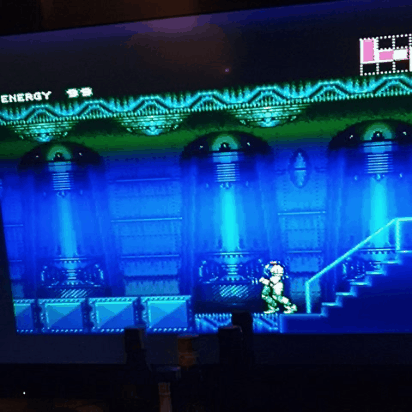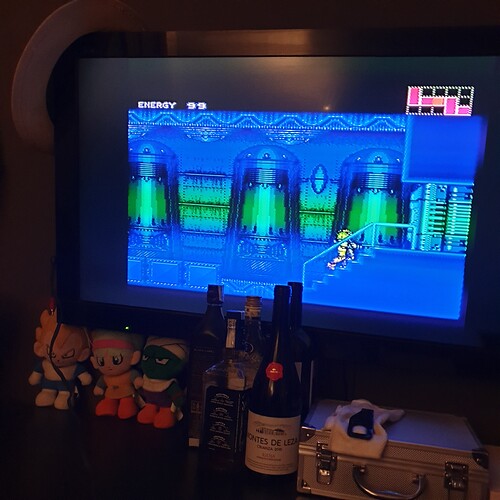Recently I have manufactured a custom stick with retroboard (rj45), db9 For Sega Genesis and db15 for mvs and Neo Geo.
The thing is, I’ve made it common Ground And I’ve joined the vcc 5v of the brook And I’ve joined the vcc 5v of the Brook Retroboard pcb and Genesis hackpad.
It goes perfect in Genesis, goes perfect in Neo Geo, goes perfect ps3 and ps4 but I have a problem when I plug the stick into a Snes (In both crt and lcd)
And several lines appear on the screen, red green and blue, They’re going up. If I disconnect the rj 45 lines disappear but if I plug it in, they reappear, what may be going on? I’ve been reading in forums for three days, and I don’t find the solution, or Someone who has happened the same thing
I hope you can help me 

I’ll leave you a video and some pictures of the problem

Got any photos of your wiring?
Maybe we can spot something you could of missed?
Extra pair of eyes never hurts
Thanks a lot! I’m going to see if I can take a picture that looks clear 
I think he means when he plugs in his controller, he gets visual artifacts.
When he unplugs it, the artifacts go away.
Perhaps something is getting short to VCC.
That makes sense, I guess.
I’ve never personally encountered this, and I’m surprised that a “faulty” controller could affect the video output that way, but I guess anything’s possible if there was a short to VCC or GND. Some pics of the wiring and the setup would be great.
Also one important thing to confirm since it sounds like the stick has 3 output connectors on it (RJ-45 for the Retroboard, and separate outputs for the DB9 Genesis padhack and the DB15 for Neo-Geo): you’re not by any chance leaving all of them connected at the same time, are you?
1 Like
Thanks for your answers, the problem is that the pcb has this problem, alone, without being connected inside the stick. and that is what makes me think that there is something on the pcb itself, despite it being simply a controller board.
here you can see the problem in video:
I have not connected the 3 consoles at the same time, I think I could fry anything!
Ok good to hear.
A couple of more tests/scenarios/questions. Does the same thing happen if you:
- plug in any other controller?
- plug the Brook Retro Board into the Player 2 slot?
- leave the RJ45-SNES cable plugged in, but disconnect it at the PCB side (ie, plug in just the cable)?
Would help narrow things down.
Thank you for your help,
1.When I connect a Super Nes pad, there’s no problem on the screen, no artifacts or interferences.
-
When I plug the Retroboard into the Player 2 slot, problems reappear
-
When I connect only the rj45 to snes cable, no artifact appears
Ok, that helps a lot.
Then this definitely feels like there’s some short from some signal, most likely one of the signals used by SNES but not USB for PS3.
VCC and GND are pins 8 and 1 respectively and these are used for all platforms.
USB’s D-/D+ lines are pins 5 and 6.
SNES cables don’t use pins 5/6, but use 2/4/7 instead.
Chances are that there is a short from one of the pins of 2/4/7 on the RJ45 to either VCC or GND.
2 last questions:
- Is there a way for you to test your RJ45-SNES cable with another PCB?
- Do you have another RJ45-SNES cable to test with this Retro Board PCB?
It would help narrow down whether or not the potential short is in the cable, or on the PCB itself.
Thanks again, buddy, this is a slightly special pcb with drivers, at least on Windows 10
That said, I’ve done several tests. I got a couple of rf scart cables and a couple of power supplies, one of them, original from Nintendo.
I tested with a crt, an original rf cable and one more snes, different from the usual… And woalá, everything was fine
I think the combination of a third partie power ac, a rf cable that is also not original And a normal pad, everything’s going moderately well. But when putting retroboard, perhaps the consumption of it is superior resulting in an imbalance.
Sorry for repost… Excuse me, I have a doubt, I’ve read all about dual mod 101, and there’s something I haven’t gotten to know for sure
The golden rule says that both pcbs must be connected in both vcc 5v and Gnd. But I wonder, it also has to be connected to the 5v vcc pin of the db15 port?
Right now gnd is common for the three systems, both the sega genesis hackpad, and the brook Retroboard, and the db15 port
![]()
![]()



